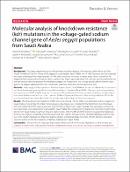| dc.contributor.author | Abadi, M. Mashlawi | |
| dc.contributor.author | Ashwaq, M. Al‑Nazawi | |
| dc.contributor.author | Elsiddig, M. Noureldin | |
| dc.contributor.author | Hussain, Alqahtani | |
| dc.contributor.author | Jazem, A. Mahyoub | |
| dc.contributor.author | Jassada, Saingamsook | |
| dc.contributor.author | Mustapha, Debboun | |
| dc.contributor.author | Martha, Kaddumukasa | |
| dc.contributor.author | Hesham, M. Al‑Mekhlafi | |
| dc.contributor.author | Catherine, Walton | |
| dc.date.accessioned | 2024-02-07T09:47:50Z | |
| dc.date.available | 2024-02-07T09:47:50Z | |
| dc.date.issued | 2022 | |
| dc.identifier.citation | Mashlawi, A. M., Al-Nazawi, A. M., Noureldin, E. M., Alqahtani, H., Mahyoub, J. A., Saingamsook, J., ... & Walton, C. (2022). Molecular analysis of knockdown resistance (kdr) mutations in the voltage-gated sodium channel gene of Aedes aegypti populations from Saudi Arabia. Parasites & Vectors, 15(1), 1-13. | en_US |
| dc.identifier.uri | https://hdl.handle.net/20.500.12504/1599 | |
| dc.description.abstract | Background: The Aedes aegypti mosquito is the primary vector for dengue, chikungunya, yellow fever and Zika
viruses worldwide. The first record of Ae. aegypti in southwestern Saudi Arabia was in 1956. However, the first outbreak
and cases of dengue fever were reported in 1994, and cases have increased in recent years. Vector control for Ae.
aegypti mainly uses pyrethroid insecticides in outdoor and indoor space spraying. The constant use of pyrethroids has
exerted intense selection pressure for developing target-site mutations in the voltage-gated sodium channel (vgsc)
gene in Ae. Aegypti against pyrethroids—mutations that have led to knockdown resistance (kdr).
Methods: Aedes aegypti field populations from five regions (Jazan, Sahil, Makkah, Jeddah and Madinah) of southwestern
Saudi Arabia were genotyped for known kdr mutations in domains IIS6 and IIIS6 of the vgsc gene using polymerase
chain reaction (PCR) amplification and sequencing. We estimated the frequency of kdr mutations and genotypes
from Saudi Arabia as well as from other countries, Thailand, Myanmar (Southeast Asia) and Uganda (East Africa). We
constructed haplotype networks to infer the evolutionary relationships of these gene regions.
Results: The three known kdr mutations, S989P, V1016G (IIS6) and F1534C (IIIS6), were detected in all five regions of
Saudi Arabia. Interestingly, the triple homozygous wild genotype was reported for the first time in two individuals
from the highlands of the Jazan region and one from the Al-Quoz, Sahil region. Overall, nine genotypes comprising
four haplotypes were observed in southwestern Saudi Arabia. The median-joining haplotype networks of eight populations
from Saudi Arabia, Southeast Asia and East Africa for both the IIS6 and IIIS6 domains revealed that haplotype
diversity was highest in Uganda and in the Jazan and Sahil regions of Saudi Arabia, whereas haplotype diversity was
low in the Jeddah, Makkah and Madinah regions. Median-joining haplotype networks of both domains indicated
selection acting on the kdr-mutation containing haplotypes in Saudi Arabia.
Conclusions: The presence of wild type haplotypes without any of the three kdr mutations, i.e. that are fully susceptible,
in Saudi Arabia indicates that further consideration should be given to insecticide resistance management strategies that could restore pyrethroid sensitivity to the populations of Ae. aegypti in Saudi Arabia as part of an integrative
vector control strategy. | en_US |
| dc.language.iso | en | en_US |
| dc.publisher | BMC Parasites & Vectors | en_US |
| dc.subject | Aedes aegypti | en_US |
| dc.subject | Insecticide resistance | en_US |
| dc.subject | Knockdown resistance | en_US |
| dc.subject | Mutations | en_US |
| dc.subject | Median-joining haplotype network | en_US |
| dc.subject | Haplotype | en_US |
| dc.subject | Saudi Arabia | en_US |
| dc.title | Molecular analysis of knockdown resistance (kdr) mutations in the voltage‑gated sodium channel gene of Aedes aegypti populations from Saudi Arabia | en_US |
| dc.type | Article | en_US |

